Building Energy Efficiency for Indoor Heating Temperature Set-Point: Mechanism and Case Study of Mid-Rise Apartment
Abstract
1. Introduction
2. Materials and Methods
2.1. Geographic Locations
2.2. Building Information
2.3. Load Forecasting Methods
3. Climatic Differences of Energy-Saving Principle
3.1. Comparison of Annual Energy-Saving Effects
3.2. Micro-Energy-Saving Mechanism
3.2.1. Hourly Heating Load Reduction (HLR) Amount
3.2.2. Microscopic Heating Saving Mechanism
- (I)
- Temperature difference saving (TDS) mechanism: for the hours distributed on the approximate horizontal line, even though those hours are subject to external disturbance, internal disturbance and building envelope effects, their indoor characteristic temperatures are still lower than 19 °C, which means that in these hours there is still heating demand. The hourly HLR amount of these hours depends on the heat transfer coefficient, building areas and Tsp reduction range (1 °C in this paper). According to the characteristics of the building and the envelope in this study, the hourly HLR amount tends to a constant of about 2.43 kW, which has no correlation to the city climates. However, the cumulative TDS amount of the whole year is directly proportional to the numbers of the TDS hours, and the annual TDS amount is closely related to the city climates.
- (II)
- Behavioral saving (BS) mechanism: for the scattered hours in Figure 5, the heating demand is small when the heating Tsp is 20 °C. Two kinds of conditions are included: one is when the outdoor temperature is between 20 °C and 19 °C, and if the Tsp is reduced from 20 °C to 19 °C, the hourly heating demand will change to be no longer needed because of changing the temperature setpoint. Another is when the outdoor temperature is lower than 19 °C, and if the indoor characteristic temperature is between 20 °C and 19 °C because of the heat gain from the solar radiation and the inner heat sources, the hourly heating demand will also change and no longer be required. The two kinds of conditions are defined as the BS mechanism. The BS amount varies widely and the cumulative annual BS amount is related to the city climates, the internal disturbance and the BS hours, the complicated mechanism is involved.
3.2.3. Hourly Heating Load Reduction (HLR) Rate
3.3. Climatic Difference of Energy-Saving Principle
4. Characteristics of the Energy-Saving Principle
4.1. Effects of New and Old Buildings Completed in Different Years
4.2. Effects of the Occupancy Behavior
5. Discussion
6. Conclusions and Prospects
- Hours with indoor temperatures below 19 °C due to external/internal disturbance and building envelope have heating demand, with the hourly heating demand depending on U-value, F-value and Tsp reduction. These hours are defined as TDS hours, and their hourly HSA tends to a constant. The fixed value of TDS hours is only related to the U-value of the building envelope, not the climatic conditions, so when the U-value is determined, the hourly TDS amount is defined as the TDS constant.
- When the outdoor temperature is between 20 °C and 19 °C, if the Tsp is reduced from 20 °C to 19 °C, the hourly heating demand will no longer be needed because of changing the temperature setpoint. When the outdoor temperature is lower than 19 °C, if the indoor characteristic temperature is between 20 °C and 19 °C because of the heat gain from the solar radiation and the inner heat sources, the hourly heating demand will no longer be needed. Those hours in the above situations are defined as the BS hours.
- The energy-saving effects of lowering the heating Tsp is determined by two completely different kinds of hours. One kind is the TDS hours, the hourly HSA of which is almost a constant. Another kind is the BS hours, the hourly HSA of which is between the zero-value and the TDS constant. The annual HSA is composed of the TDS amount and the BS amount, and the annual cumulative TDS amount is proportional to the TDS hours.
- The climatic dissimilarity in the energy-saving principle of lowering the heating Tsp is revealed. The annual TDS amount depends on the numbers of TDS hours, which account for a large percentage, so the dissimilarity of the annual HSA in different cities mainly depends on the dissimilarity of the heating hours. Similarly, the annual HSR tends to be the hours when the heating demand is large and the percentage is huge. Since the TDS amount for those hours are the same for cities with different climates, the hourly HSR is a single-valued function that is inversely proportional to the heating load. The cities with higher heating load demand have the lower annual HSR.
- The TDS mechanism dominates the heating savings from Tsp reduction for a specific building, regardless of completed periods and internal heat sources. The annual HSA decreases with building completion, but HSR remains unchanged. Occupancy behavior decreases TDS dominance, but TDS can still account for up to 80% of savings. HSR increases to varying degrees, especially in warmer cities. When considering completed periods, occupancy behavior and work–rest schedule, TDS dominance weakens and HSR increases further. It is important to reveal the energy-saving mechanism for effective conservation and emission reduction. These findings are valuable for regional standards and resident behavioral energy-saving.
- A mid-rise apartment is chosen as the case building here, with certain geometric and thermal parameters. Changes of building types (high-rise apartments, public buildings, factory, etc.), room geometry (location, facing direction, ratio of window to wall, etc.), and thermal properties of building envelopes (thermal conductivity, density, specific heat, solar radiation absorption ratio, etc.) can contribute to different air conditioning loads for indoor space heating.
- Dynamic climatic conditions play a significant role in determining specific building energy consumption, in terms of dynamic temperature variation impacting both indoor load demands and thermal performance of air conditioning or heating devices. Only eight typical big cities in different climatic zones are discussed here. While for building space heating in other places including both cities and countryside located in various global climatic regions, the situations should be quite different even for the same studied building.
- Practical building heating energy consumption also depends on the types and thermal performance of used heating equipment and systems, such as air-source heat pump, ground-source heat pump, floor radiant air conditioner, and solar thermal systems etc. In practical engineering, the building energy saving amount and rate could vary widely with different heating devices, benchmarks and reference systems, even in the same climatic zones.
Author Contributions
Funding
Data Availability Statement
Conflicts of Interest
Abbreviations
| Tsp | Temperature setpoint |
| HSA | Heating saving amount |
| HSR | Heating saving rate |
| TDS | Temperature-difference saving |
| BS | Behavioral saving |
| HLR | Heating load reduction |
| SHGC | Solar Heat Gain Coefficient |
| CTM | The Characteristic Temperature Method |
References
- Al-Marri, W.; Al-Habaibeh, A.; Watkins, M. An investigation into domestic energy consumption behaviour and public awareness of renewable energy in Qatar. Sustain. Cities Soc. 2018, 41, 639–646. [Google Scholar] [CrossRef]
- Jafarinejad, T.; Erfani, A.; Fathi, A.; Shafii, M.B. Bi-level energy-efficient occupancy profile optimization integrated with demand-driven control strategy: University building energy saving. Sustain. Cities Soc. 2019, 48, 101539. [Google Scholar] [CrossRef]
- Song, M.; Mao, N.; Xu, Y.; Deng, S. Challenges in, and the development of, building energy saving techniques, illustrated with the example of an air source heat pump. Therm. Sci. Eng. Prog. 2019, 10, 337–356. [Google Scholar] [CrossRef]
- Zanchini, E.; Naldi, C. Energy saving obtainable by applying a commercially available M-cycle evaporative cooling system to the air conditioning of an office building in North Italy. Energy 2019, 179, 975–988. [Google Scholar] [CrossRef]
- Huang, J.; Gurney, K.R. The variation of climate change impact on building energy consumption to building type and spatiotemporal scale. Energy 2016, 111, 137–153. [Google Scholar] [CrossRef]
- Gaglia, A.G.; Dialynas, E.N.; Argiriou, A.A.; Kostopoulou, E.; Tsiamitros, D.; Stimoniaris, D.; Laskos, K.M. Energy performance of European residential buildings: Energy use, technical and environmental characteristics of the Greek residential sector—Energy conservation and CO2 reduction. Energy Build. 2019, 183, 86–104. [Google Scholar] [CrossRef]
- Tsikaloudaki, K.; Laskos, K.; Theodosiou, T.; Bikas, D. Assessing cooling energy performance of windows for office buildings in the Mediterranean zone. Energy Build. 2012, 49, 192–199. [Google Scholar] [CrossRef]
- Hwang, R.; Chen, W. Creating glazed facades performance map based on energy and thermal comfort perspective for office building design strategies in Asian hot-humid climate zone. Appl. Energy 2022, 311, 118689. [Google Scholar] [CrossRef]
- Hwang, R.; Liao, W.; Chen, W. Optimization of energy use and academic performance for educational environments in hot-humid climates. Build. Environ. 2022, 222, 109434. [Google Scholar] [CrossRef]
- DeForest, N.; Shehabi, A.; Selkowitz, S.; Milliron, D.J. A comparative energy analysis of three electrochromic glazing technologies in commercial and residential buildings. Appl. Energy 2017, 192, 95–109. [Google Scholar] [CrossRef]
- Charles, A.; Maref, W.; Ouellet-Plamondon, C.M. Case study of the upgrade of an existing office building for low energy consumption and low carbon emissions. Energy Build. 2019, 183, 151–160. [Google Scholar] [CrossRef]
- Facci, A.L.; Krastev, V.K.; Falcucci, G.; Ubertini, S. Smart integration of photovoltaic production, heat pump and thermal energy storage in residential applications. Sol. Energy 2019, 192, 133–143. [Google Scholar] [CrossRef]
- DeForest, N.; Shehabi, A.; O’Donnell, J.; Garcia, G.; Greenblatt, J.; Lee, E.S.; Selkowitz, S.; Milliron, D.J. United States energy and CO2 savings potential from deployment of near-infrared electrochromic window glazings. Build. Environ. 2015, 89, 107–117. [Google Scholar] [CrossRef]
- Ghahramani, A.; Dutta, K.; Becerik-Gerber, B. Energy trade off analysis of optimized daily temperature setpoints. J. Build. Eng. 2018, 19, 584–591. [Google Scholar] [CrossRef]
- Heidarinejad, M.; Dahlhausen, M.; McMahon, S.; Pyke, C.; Srebric, J. Cluster analysis of simulated energy use for LEED certified U.S. office buildings. Energy Build. 2014, 85, 86–97. [Google Scholar] [CrossRef]
- Mao, N.; Hao, J.; Cui, B.; Li, Y.; Song, M.; Xu, Y.; Deng, S. Energy performance of a bedroom task/ambient air conditioning (TAC) system applied in different climate zones of China. Energy 2018, 159, 724–736. [Google Scholar] [CrossRef]
- Mao, N.; Hao, J.; He, T.; Song, M.; Xu, Y.; Deng, S. PMV-based dynamic optimization of energy consumption for a residential task/ambient air conditioning system in different climate zones. Renew. Energy 2019, 142, 41–54. [Google Scholar] [CrossRef]
- Yang, B.; Cheng, X.; Dai, D.; Olofsson, T.; Li, H.; Meier, A. Real-time and contactless measurements of thermal discomfort based on human poses for energy efficient control of buildings. Build. Environ. 2019, 162, 106284. [Google Scholar] [CrossRef]
- Kim, J.; Zhou, Y.; Schiavon, S.; Raftery, P.; Brager, G. Personal comfort models: Predicting individuals’ thermal preference using occupant heating and cooling behavior and machine learning. Build. Environ. 2018, 129, 96–106. [Google Scholar] [CrossRef]
- Jin, Z.N.; Zheng, Y.H.; Zhang, Y. A novel method for building air conditioning energy saving potential pre-estimation based on thermodynamic perfection index for space cooling. J. Asian Archit. Build. Eng. 2022, 1–17. [Google Scholar] [CrossRef]
- Mao, N.; Pan, D.; Song, M.; Li, Z.; Xu, Y.; Deng, S. Operating optimization for improved energy consumption of a TAC system affected by nighttime thermal loads of building envelopes. Energy 2017, 133, 491–501. [Google Scholar] [CrossRef]
- Khedher, N.B. Numerical Study of the Thermal Behavior of a Composite Phase Change Material (PCM) Room. Eng. Technol. Appl. Sci. Res. 2018, 8, 2663–2667. [Google Scholar] [CrossRef]
- Adua, L. Reviewing the complexity of energy behavior: Technologies, analytical traditions, and household energy consumption data in the United States. Energy Res. Soc. Sci. 2020, 59, 101289. [Google Scholar] [CrossRef]
- Huang, H.; Chen, L.; Mohammadzaheri, M.; Hu, E. A New Zone Temperature Predictive Modeling for Energy Saving in Buildings. Procedia Eng. 2012, 49, 142–151. [Google Scholar] [CrossRef]
- ANSI/ASHRAE Standard 55-2013; Thermal Environmental Conditions for Human Occupancy. American Society of Heating, Refrigerating, and Air-Conditioning Engineers, Inc.: Atlanta, GA, USA, 2013; p. 58.
- Gianniou, P.; Reinhart, C.; Hsu, D.; Heller, A.; Rode, C. Estimation of temperature setpoints and heat transfer coefficients among residential buildings in Denmark based on smart meter data. Build. Environ. 2018, 139, 125–133. [Google Scholar] [CrossRef]
- Lin, Z.; Deng, S. A study on the characteristics of nighttime bedroom cooling load in tropics and subtropics. Build. Environ. 2004, 39, 1101–1114. [Google Scholar] [CrossRef]
- Krese, G.; Lampret, Ž.; Butala, V.; Prek, M. Determination of a Building’s balance point temperature as an energy characteristic. Energy 2018, 165, 1034–1049. [Google Scholar] [CrossRef]
- Lin, Z.; Deng, S. The outdoor air ventilation rate in high-rise residences employing room air conditioners. Build. Environ. 2003, 38, 1389–1399. [Google Scholar] [CrossRef]
- Veselý, M.; Zeiler, W. Personalized conditioning and its impact on thermal comfort and energy performance—A review. Renew. Sustain. Energy Rev. 2014, 34, 401–408. [Google Scholar] [CrossRef]
- Sigrimis, N.; Ferentinos, K.P.; Arvanitis, K.G.; Anastasiou, A. A Comparison of Optimal Greenhouse Heating Setpoint Generation Algorithms for Energy Conservation. IFAC Proc. 2001, 34, 61–66. [Google Scholar] [CrossRef]
- Chowdhury, A.A.; Rasul, M.G.; Khan, M.M.K. Analysis of Energy Performance of Institutional Buildings in Subtropical Climate. Energy Procedia 2017, 110, 604–610. [Google Scholar] [CrossRef]
- Hoyt, T.; Arens, E.; Zhang, H. Extending air temperature setpoints: Simulated energy savings and design considerations for new and retrofit buildings. Build. Environ. 2015, 88, 89–96. [Google Scholar] [CrossRef]
- Bionda, D.; Domingo-Irigoyen, S. Energy saving potential of occupancy-based heating control in residential buildings. Energy Procedia 2017, 122, 27–31. [Google Scholar] [CrossRef]
- Heidarinejad, M.; Dalgo, D.A.; Mattise, N.W.; Srebric, J. Personalized cooling as an energy efficiency technology for city energy footprint reduction. J. Clean. Prod. 2018, 171, 491–505. [Google Scholar] [CrossRef]
- Energy USDO. Available online: https://www.energyplus.net/weather (accessed on 1 January 2022).
- ANSI/ASHRAE Standard 169-2013; Climatic Data for Building Design Standards. American Society of Heating, Refrigerating, and Air-Conditioning Engineers, Inc.: Atlanta, GA, USA, 2013.
- Office of Energy Efficiency & Renewable Energy | Department of Energy. Available online: https://www.energy.gov/eere/office-energy-efficiency-renewable-energy (accessed on 1 January 2022).
- Standard 62.1-2004; Ventilation for Acceptable Indoor Air Quality. American Society of Heating, Refrigerating, and Air-Conditioning Engineers, Inc.: Atlanta, GA, USA, 2004.
- Long, E.S. Identifications: The relative variation rates (RVRs) of cooling and heating are approximately the same in different cities with the same increase of shape coefficients. Build. Environ. 2005, 40, 481–488. [Google Scholar]
- Guo, S.; Yang, H.; Li, Y.; Zhang, Y.; Long, E. Energy saving effect and mechanism of cooling setting temperature increased by 1 °C for residential buildings in different cities. Energy Build. 2019, 202, 109335. [Google Scholar] [CrossRef]
- Kegel, M.; Tamasauskas, J.; Sunye, R. Solar Thermal Trigeneration System in a Canadian Climate Multi-unit Residential Building. Energy Procedia 2014, 48, 876–887. [Google Scholar] [CrossRef]



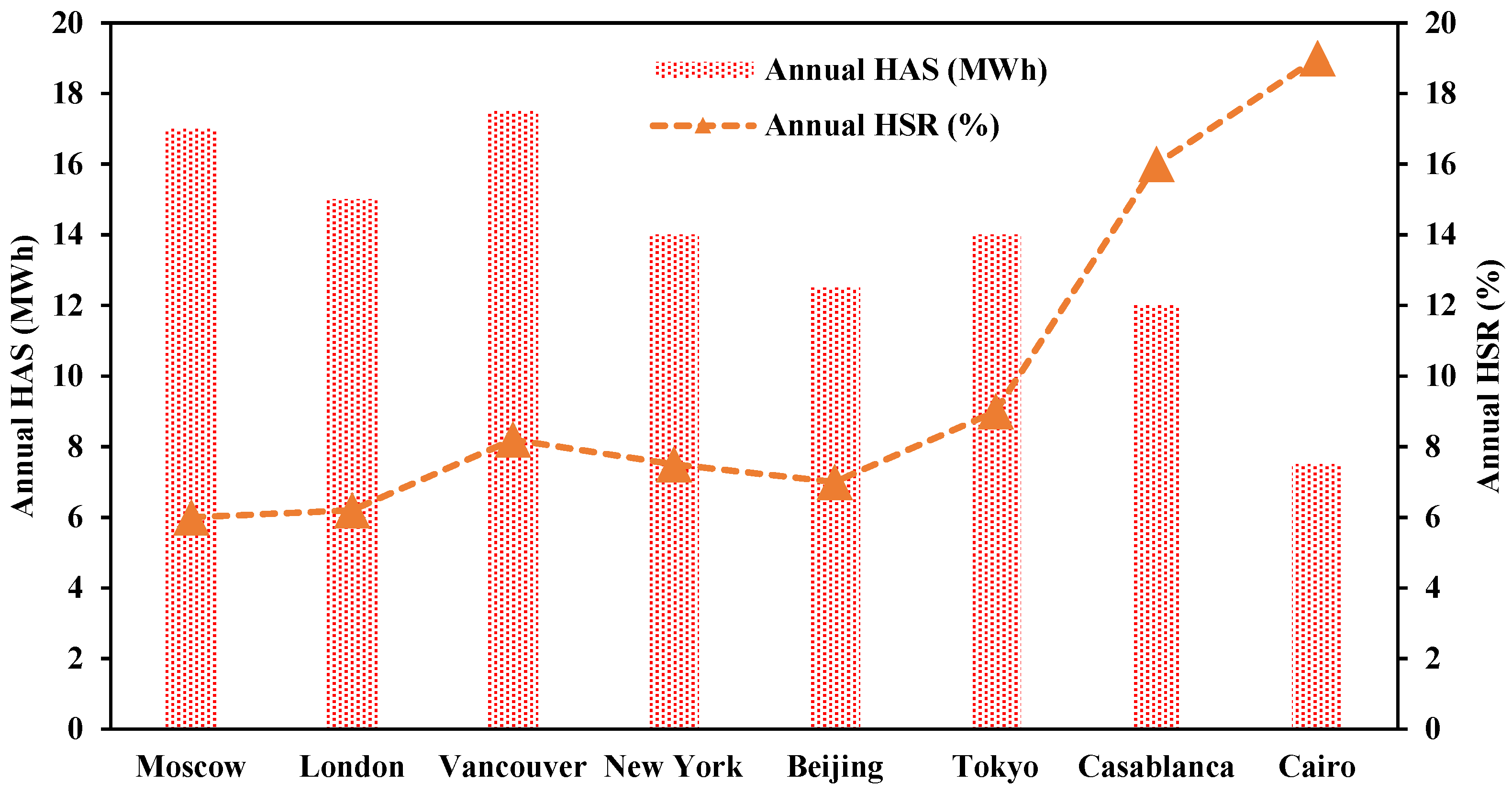
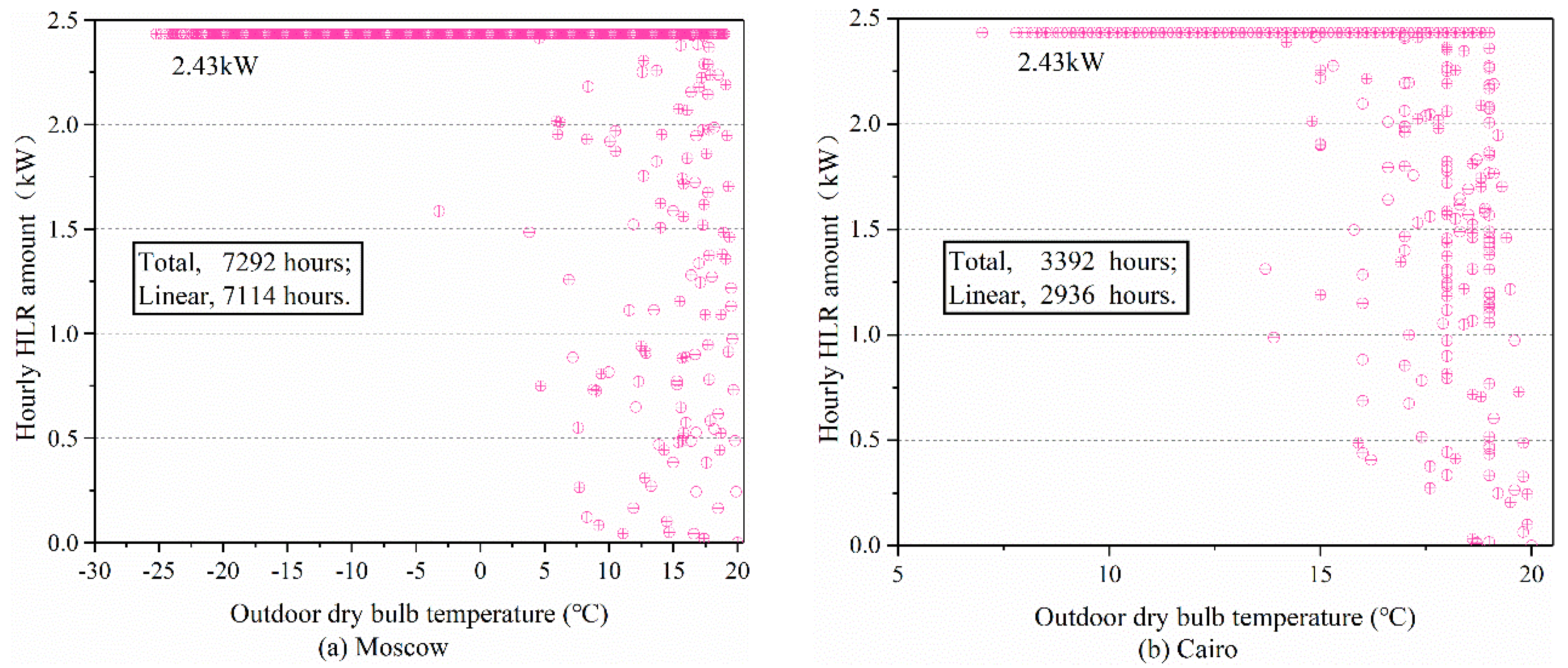
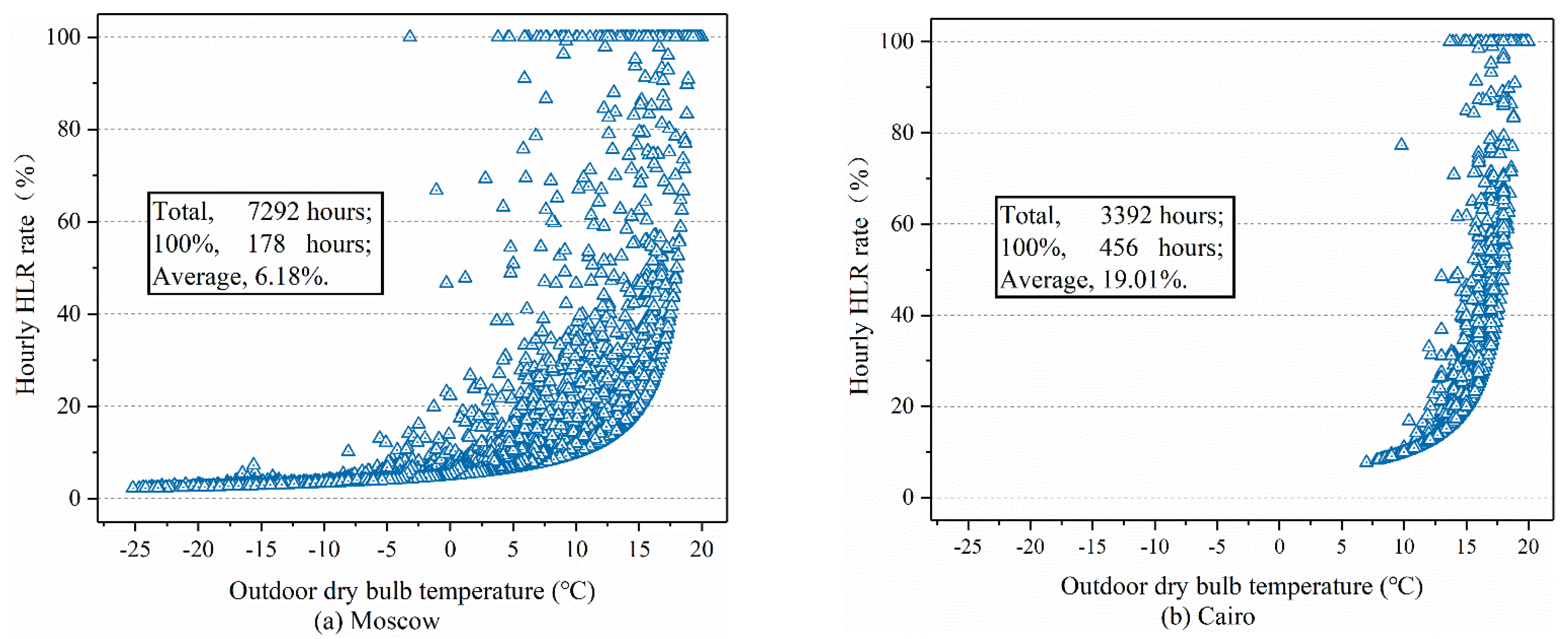
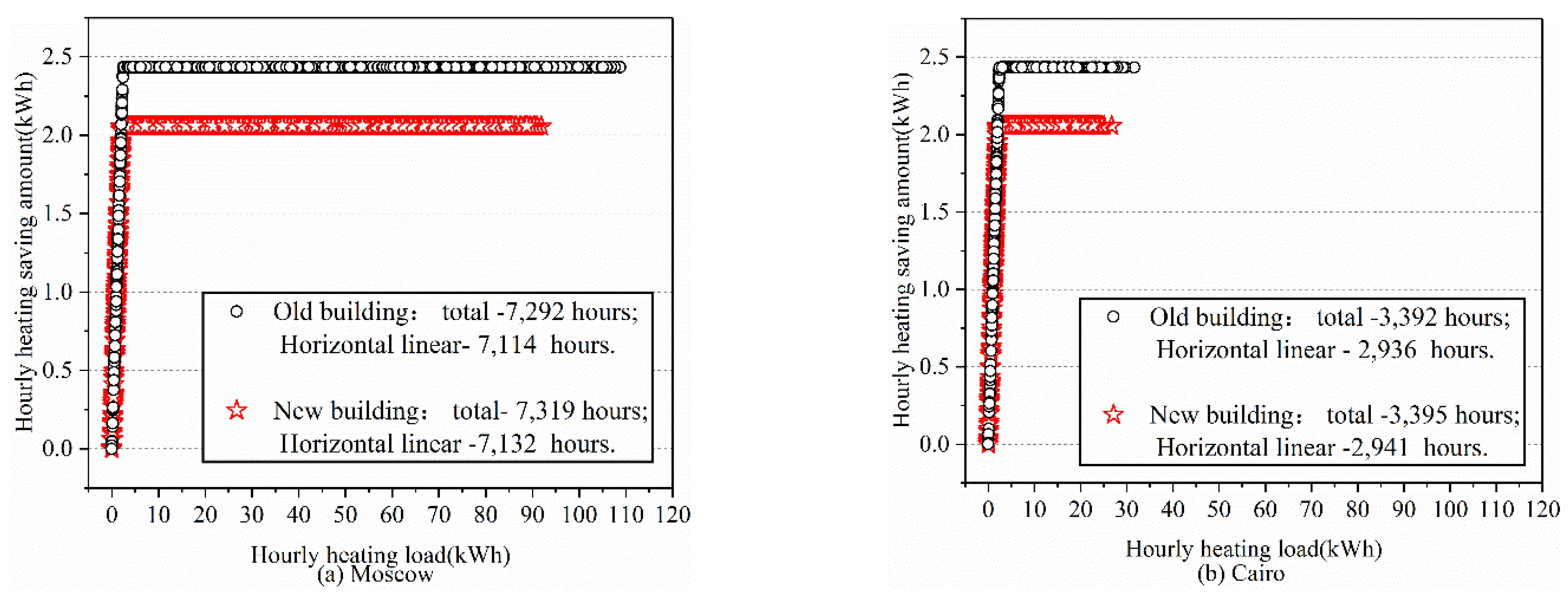
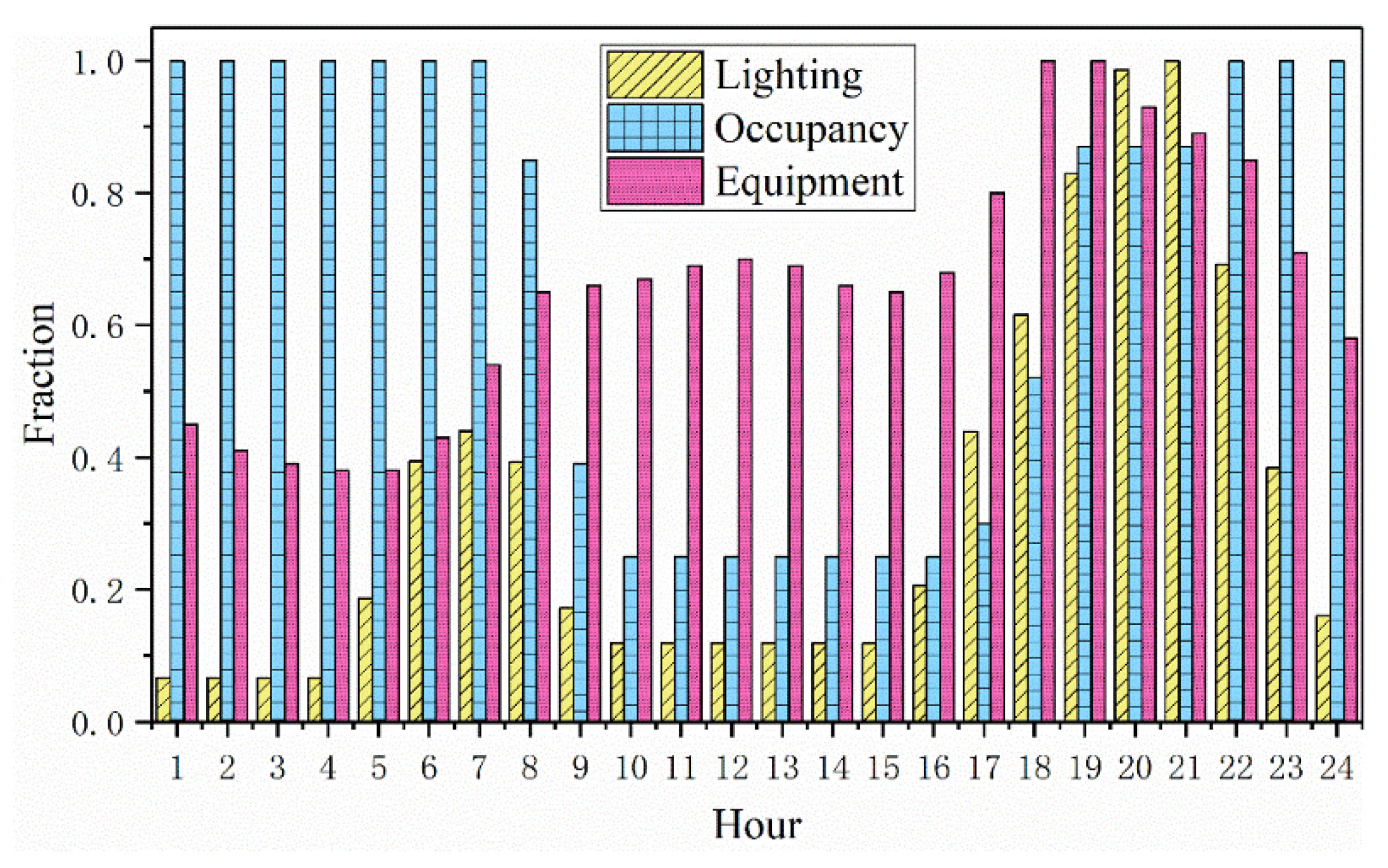
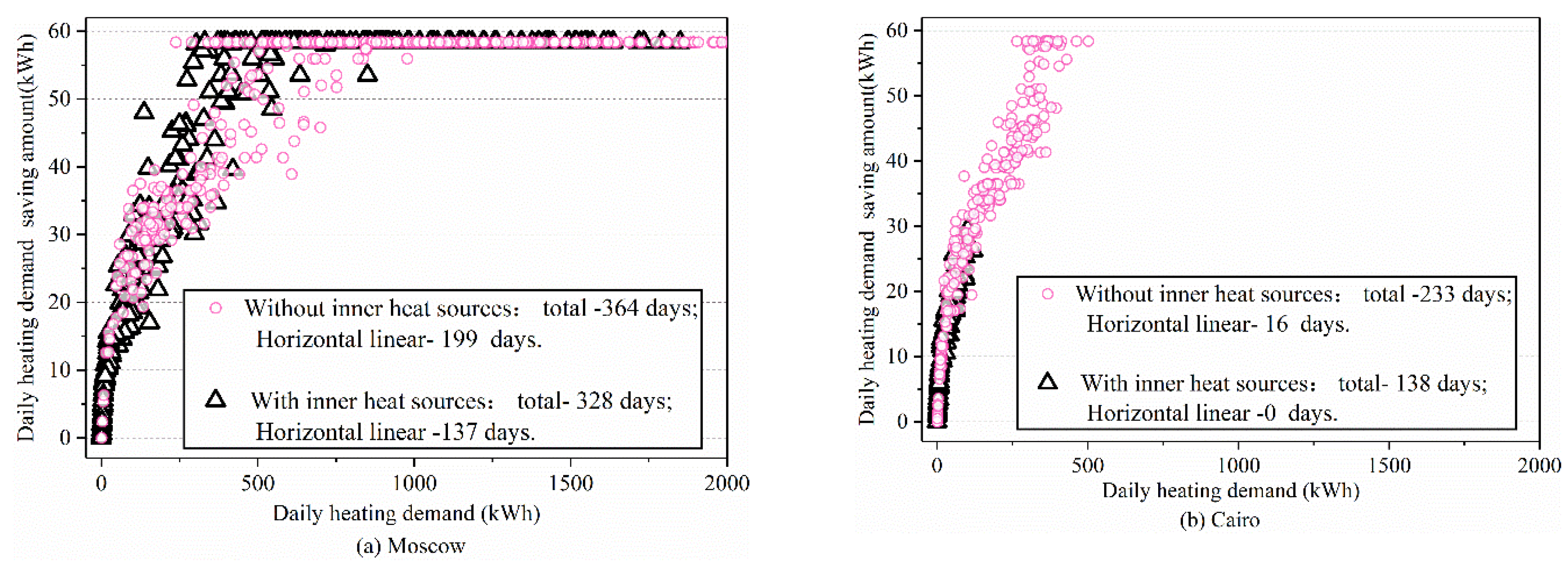
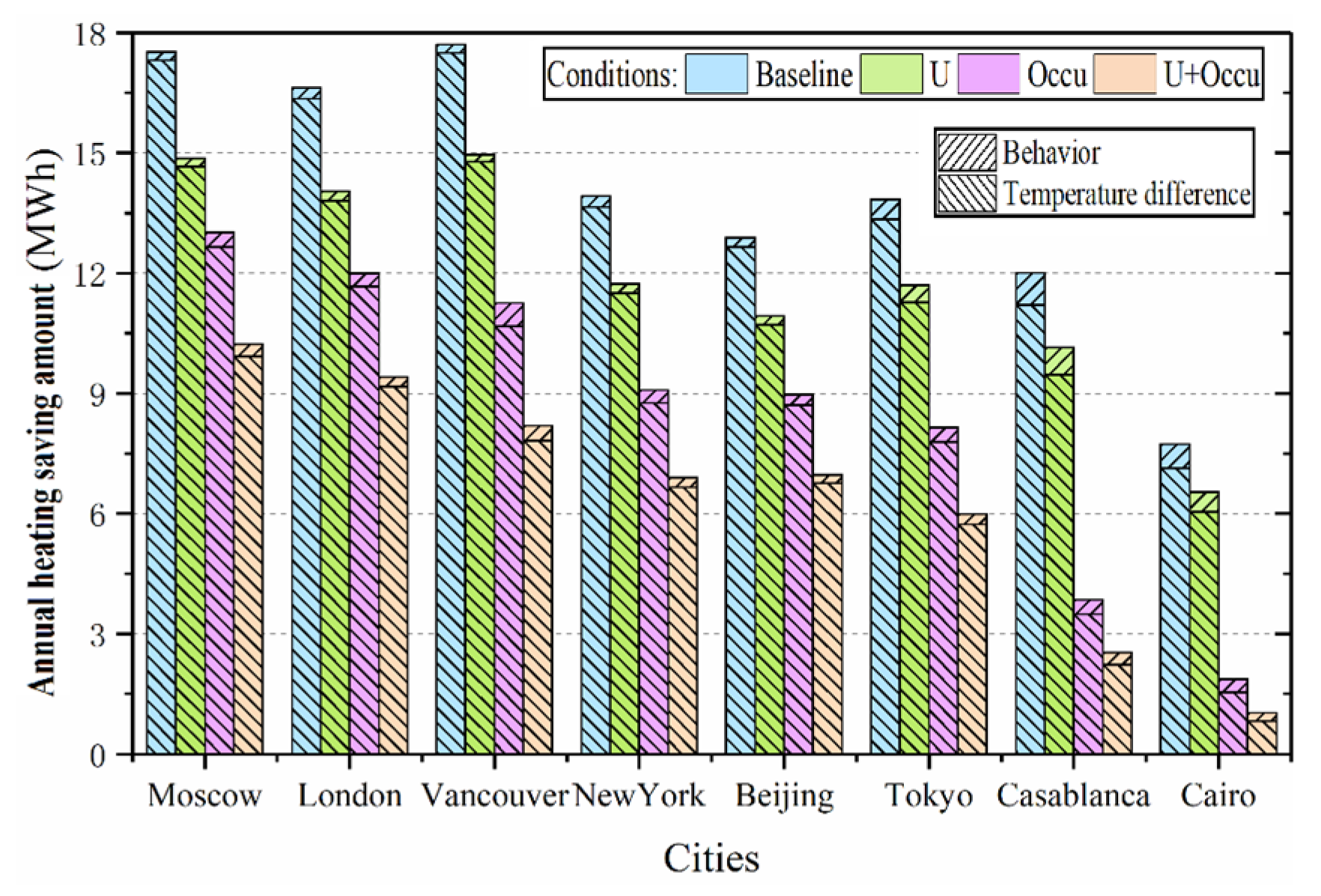
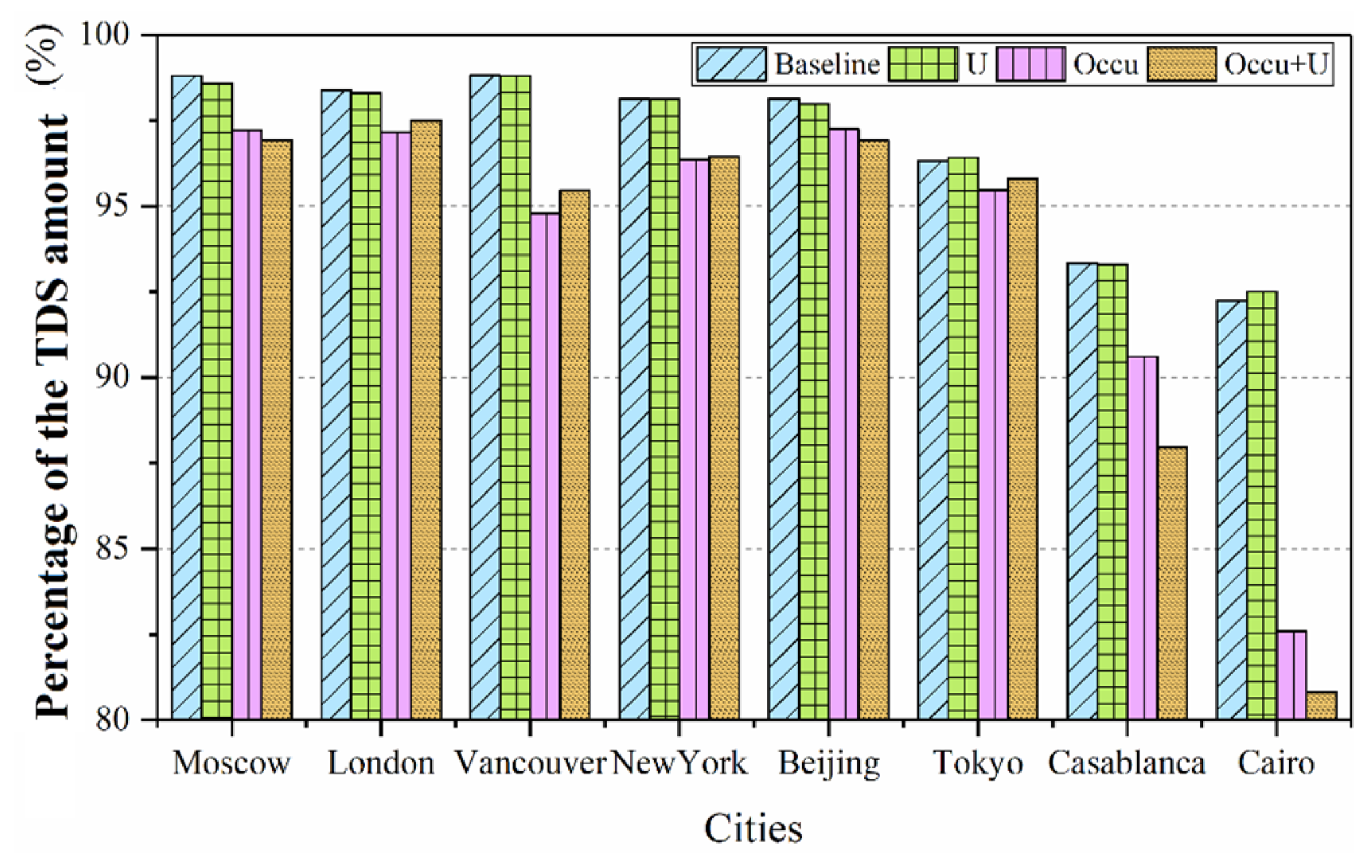
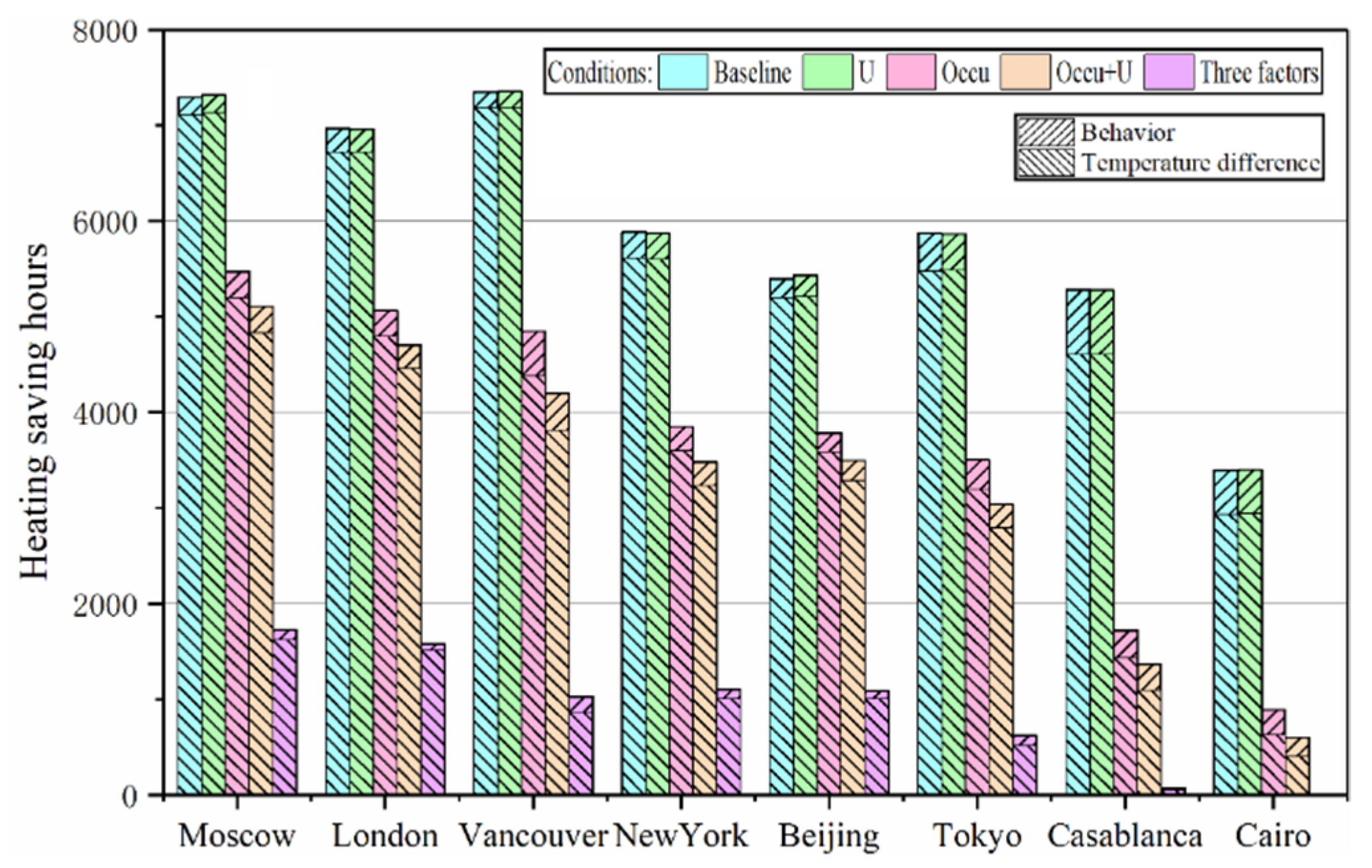
| States | Cities | Climate Zones | Latitude N+ (°) | Longitude E+/W− (°) | Annual Average Temperature (°C) | Average Temperature of the Coldest Month (°C) | Annual Minimum Temperature (°C) | Annual Total Solar Radiation (MJ/m2) |
|---|---|---|---|---|---|---|---|---|
| Asia | Beijing | 3 | 39.80 | 116.47 | 12.65 | −3.83 | −14.2 | 5042.77 |
| Tokyo | 5 | 36.18 | 140.42 | 13.06 | 1.95 | −10.0 | 4704.60 | |
| Europe | London | 4 | 51.30 | 0.12 | 7.31 | −7.15 | −20.6 | 5046.15 |
| Moscow | 6 | 55.75 | 37.63 | 5.52 | −7.58 | −25.20 | 3504.07 | |
| North America | New York | 4 | 40.78 | −73.97 | 12.48 | −1.72 | −15.60 | 5299.55 |
| Vancouver | 5 | 49.18 | −123.17 | 9.74 | 3.20 | −7.20 | 4426.26 | |
| Africa | Cairo | 2 | 30.13 | 31.40 | 21.72 | 13.95 | 7.00 | 6909.36 |
| Casablanca | 2/1 | 33.37 | −7.58 | 17.32 | 11.43 | 1.00 | 6471.99 |
| Parameters | Value | Unit |
|---|---|---|
| Total floor area | 3135 | m2 |
| Total area of the external envelope | 2340 | m2 |
| Building volume | 9561 | m3 |
| Shape coefficient | 0.24 | / |
| Ratio of window to wall (W&E& S&N) | 0.15 | / |
| Heat transfer coefficient of external wall | 0.44 | W/m2·K |
| Heat transfer coefficient of external window | 3.81 | W/m2·K |
| Heat transfer coefficient of roof | 0.34 | W/m2·K |
| Heat transfer coefficient of ground | 1.32 | W/m2·K |
| Solar Heat Gain Coefficient (SHGC) | 0.39 | / |
| Cities | Heating Hours | BS Hours | TDS Hours | TDS Hours-Percentage (%) | Annual HSA (MWh) | BSA (kWh) | TDSA (MWh) | TDSA-Percentage (%) | Annual HSR |
|---|---|---|---|---|---|---|---|---|---|
| Moscow | 7292 | 178 | 7114 | 97.56 | 17.52 | 216.26 | 17.31 | 98.80 | 6.18 |
| London | 6963 | 237 | 6726 | 96.60 | 16.63 | 270.52 | 16.36 | 98.38 | 6.41 |
| Vancouver | 7350 | 158 | 7192 | 97.85 | 17.71 | 208.53 | 17.50 | 98.81 | 9.18 |
| New York | 5882 | 268 | 5614 | 95.44 | 13.92 | 264.84 | 13.66 | 98.13 | 8.08 |
| Beijing | 5397 | 215 | 5199 | 96.33 | 12.89 | 242.9 | 12.65 | 98.14 | 7.17 |
| Tokyo | 5869 | 387 | 5482 | 93.41 | 13.85 | 513.88 | 13.34 | 96.32 | 9.05 |
| Casablanca | 5280 | 674 | 4606 | 87.23 | 12.01 | 806.93 | 11.21 | 93.34 | 15.89 |
| Cairo | 3392 | 456 | 2936 | 86.56 | 7.74 | 599.01 | 7.14 | 92.25 | 19.01 |
| Cities | Heating Hours | BS Hours | TDS Hours | TDS Hours-Percentage (%) | Annual HSA (MWh) | BSA (kWh) | TDSA (MWh) | TDSA-Percentage (%) | Annual HSR |
|---|---|---|---|---|---|---|---|---|---|
| Moscow | 7319 | 187 | 7132 | 97.45 | 14.87 | 203.35 | 14.66 | 98.59 | 6.18 |
| London | 6959 | 240 | 6719 | 96.55 | 14.05 | 231.87 | 13.81 | 98.29 | 6.42 |
| Vancouver | 7352 | 165 | 7187 | 97.76 | 14.96 | 181.81 | 14.78 | 98.80 | 9.17 |
| New York | 5868 | 270 | 5598 | 95.40 | 11.73 | 225.64 | 11.51 | 98.12 | 8.08 |
| Beijing | 5433 | 225 | 5208 | 95.86 | 10.93 | 222.40 | 10.71 | 97.99 | 7.17 |
| Tokyo | 5865 | 379 | 5486 | 93.54 | 11.70 | 422.52 | 11.28 | 96.41 | 9.04 |
| Casablanca | 5275 | 669 | 4606 | 87.32 | 10.15 | 677.42 | 9.47 | 93.30 | 15.87 |
| Cairo | 3395 | 454 | 2941 | 86.63 | 6.54 | 498.01 | 6.05 | 92.51 | 19.01 |
| Cities | Heating Hours | BS Hours | TDS Hours | TDS Hours-Percentage (%) | Annual HSA (MWh) | BSA (kWh) | TDSA (MWh) | TDSA-Percentage (%) | Annual HSR |
|---|---|---|---|---|---|---|---|---|---|
| Moscow | 5471 | 272 | 5199 | 95.03 | 13.01 | 363.22 | 12.65 | 97.21 | 8.11 |
| London | 5064 | 271 | 4793 | 94.65 | 12.00 | 342.08 | 11.66 | 97.15 | 8.32 |
| Vancouver | 4846 | 459 | 4387 | 90.53 | 11.26 | 586.52 | 10.67 | 94.79 | 15.57 |
| New York | 3851 | 251 | 3600 | 93.48 | 9.09 | 332.12 | 8.76 | 96.35 | 11.39 |
| Beijing | 3785 | 201 | 3584 | 94.69 | 8.97 | 247.56 | 8.72 | 97.24 | 9.67 |
| Tokyo | 3503 | 305 | 3198 | 91.29 | 8.15 | 369.15 | 7.78 | 95.47 | 12.85 |
| Casablanca | 1719 | 282 | 1437 | 83.60 | 3.86 | 362.50 | 3.50 | 90.61 | 24.34 |
| Cairo | 889 | 257 | 632 | 71.09 | 1.86 | 324.05 | 1.54 | 82.59 | 39.87 |
| Cities | Heating Hours | BS Hours | TDS Hours | TDS Hours-Percentage (%) | Annual HSA (MWh) | BSA (kWh) | TDSA (MWh) | TDSA-Percentage (%) | Annual HSR |
|---|---|---|---|---|---|---|---|---|---|
| Moscow | 5110 | 283 | 4827 | 94.46 | 10.24 | 314.04 | 9.92 | 96.93 | 8.48 |
| London | 4701 | 237 | 4464 | 94.96 | 9.41 | 236.06 | 9.18 | 97.49 | 12.11 |
| Vancouver | 4202 | 393 | 3809 | 90.65 | 8.20 | 372.43 | 7.83 | 95.46 | 16.91 |
| New York | 3477 | 241 | 3236 | 93.07 | 6.90 | 245.09 | 6.65 | 96.45 | 8.75 |
| Beijing | 3498 | 210 | 3288 | 94.00 | 6.97 | 215.09 | 6.76 | 96.92 | 10.23 |
| Tokyo | 3037 | 247 | 2790 | 91.87 | 5.99 | 252.36 | 5.74 | 95.79 | 13.54 |
| Casablanca | 1366 | 277 | 1089 | 79.72 | 2.55 | 306.45 | 2.24 | 87.96 | 26.59 |
| Cairo | 599 | 194 | 405 | 67.61 | 1.03 | 197.61 | 0.83 | 80.82 | 47.22 |
| Cities | Heating Hours | BS Hours | TDS Hours | TDS Hours-Percentage (%) | Annual HSA (MWh) | BSA (kWh) | TDSA (MWh) | TDSA-Percentage (%) | Annual HSR |
|---|---|---|---|---|---|---|---|---|---|
| Moscow | 1724 | 105 | 1619 | 93.91 | 3.44 | 114.63 | 3.33 | 96.80 | 9.06 |
| London | 1580 | 66 | 1514 | 95.82 | 3.18 | 71.83 | 3.11 | 97.80 | 9.78 |
| Vancouver | 1025 | 156 | 869 | 84.78 | 1.94 | 151.18 | 1.79 | 92.27 | 22.92 |
| New York | 1104 | 98 | 1006 | 91.12 | 2.18 | 111.12 | 2.07 | 94.95 | 14.45 |
| Beijing | 1085 | 80 | 1005 | 92.63 | 2.15 | 81.36 | 2.07 | 96.28 | 13.06 |
| Tokyo | 621 | 100 | 521 | 83.90 | 1.18 | 108.10 | 1.07 | 90.68 | 25.06 |
| Casablanca | 73 | 18 | 55 | 75.34 | 0.13 | 17.66 | 0.11 | 84.62 | 32.20 |
| Cairo | 2 | 2 | 0 | 0.00 | 0.11 | 1.14 | 0 | 0.00 | 100 |
Disclaimer/Publisher’s Note: The statements, opinions and data contained in all publications are solely those of the individual author(s) and contributor(s) and not of MDPI and/or the editor(s). MDPI and/or the editor(s) disclaim responsibility for any injury to people or property resulting from any ideas, methods, instructions or products referred to in the content. |
© 2023 by the authors. Licensee MDPI, Basel, Switzerland. This article is an open access article distributed under the terms and conditions of the Creative Commons Attribution (CC BY) license (https://creativecommons.org/licenses/by/4.0/).
Share and Cite
Qi, X.; Zhang, Y.; Jin, Z. Building Energy Efficiency for Indoor Heating Temperature Set-Point: Mechanism and Case Study of Mid-Rise Apartment. Buildings 2023, 13, 1189. https://doi.org/10.3390/buildings13051189
Qi X, Zhang Y, Jin Z. Building Energy Efficiency for Indoor Heating Temperature Set-Point: Mechanism and Case Study of Mid-Rise Apartment. Buildings. 2023; 13(5):1189. https://doi.org/10.3390/buildings13051189
Chicago/Turabian StyleQi, Xingyu, Yin Zhang, and Zhineng Jin. 2023. "Building Energy Efficiency for Indoor Heating Temperature Set-Point: Mechanism and Case Study of Mid-Rise Apartment" Buildings 13, no. 5: 1189. https://doi.org/10.3390/buildings13051189
APA StyleQi, X., Zhang, Y., & Jin, Z. (2023). Building Energy Efficiency for Indoor Heating Temperature Set-Point: Mechanism and Case Study of Mid-Rise Apartment. Buildings, 13(5), 1189. https://doi.org/10.3390/buildings13051189







